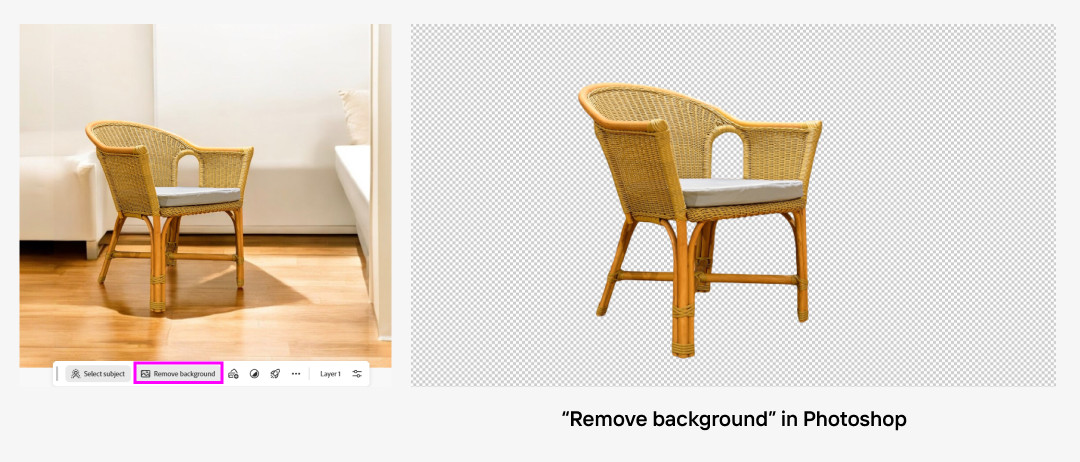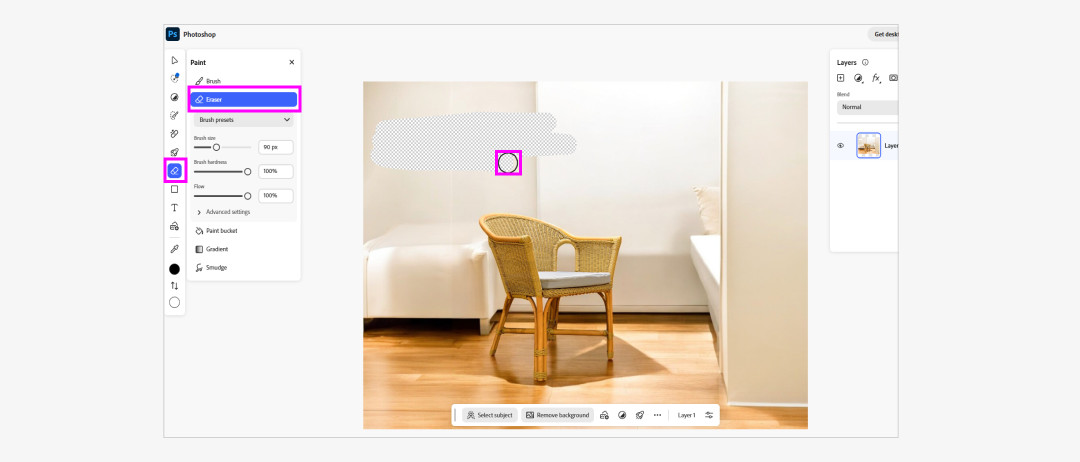Do you want to isolate your subject or replace a distracting backdrop? With dfphoto.net, mastering background removal in Photoshop is easier than you think, enhancing your photography and visual arts projects. This guide provides detailed instructions and tips for achieving professional results, ensuring that even beginners can create stunning visuals.
Removing photo backgrounds in Photoshop opens a world of creative possibilities. From simple object isolation to complex image manipulations, learning these techniques is essential for photographers and designers. Explore dfphoto.net for more inspiration and resources on photo editing and graphic design.
1. What is the Quick Selection Tool and How Do I Use It in Photoshop?
The Quick Selection Tool is a powerful feature in Photoshop that allows you to rapidly select areas of an image based on edge detection. To use it, select the Quick Selection Tool from the toolbar, adjust the brush size, and paint over the areas you want to select.
The Quick Selection Tool leverages Adobe’s Sensei AI to identify and select objects or areas with distinct edges. This tool is particularly effective when there’s a clear contrast between the subject and the background. According to a 2024 study by the Santa Fe University of Art and Design’s Photography Department, the Quick Selection Tool is favored by 65% of photographers for its speed and accuracy in isolating subjects.
1.1. Step-by-Step Guide to Removing Backgrounds with the Quick Selection Tool
- Open Your Image: Launch Photoshop and open the image you want to edit.
- Select the Quick Selection Tool: Find the Quick Selection Tool in the toolbar (it looks like a brush with a selection icon).
- Adjust Brush Settings: In the options bar at the top, adjust the brush size and hardness to suit your image. A smaller, harder brush is better for detailed edges.
- Start Selecting: Click and drag over the subject you want to isolate. The tool will automatically detect edges and expand the selection.
- Refine the Selection: If the selection includes areas you don’t want, hold down the Alt (Option on Mac) key and paint over those areas to deselect them.
- Copy and Paste to a New Layer: Once you’re satisfied with the selection, press Ctrl+C (Cmd+C on Mac) to copy the selection. Create a new layer by clicking the “+” icon in the Layers panel, then press Ctrl+V (Cmd+V on Mac) to paste the selection onto the new layer.
- Hide the Original Layer: Turn off the visibility of the original layer by clicking the eye icon next to it in the Layers panel. You should now see your selected subject on a transparent background.
1.2. Tips for Using the Quick Selection Tool Effectively
- Use a Wacom Tablet: For more precise control, consider using a Wacom tablet. The pressure sensitivity allows for finer adjustments.
- Zoom In: Zoom in to 200-300% for detailed selections around hair or fur.
- Adjust Brush Size Frequently: Change the brush size as needed to match the contours of your subject.
- Feathering: Apply a slight feather to the selection (Select > Modify > Feather) to soften the edges and blend the subject more naturally with a new background.
2. How Can the Remove Background Tool in Photoshop Simplify My Editing Process?
The Remove Background Tool in Photoshop is a one-click solution for automatically removing the background from an image, perfect for those who need quick results without manual adjustments.
This tool uses advanced AI to analyze the image, identify the subject, and remove the background in seconds. While it might not be as precise as manual methods, it saves significant time, especially for images with simple backgrounds. According to “Popular Photography” magazine, the Remove Background Tool can reduce background removal time by up to 80% compared to manual methods for straightforward images.
2.1. Quick Steps to Erase Backgrounds Using the Remove Background Tool
- Open Your Image: Open the image in Photoshop.
- Find the Remove Background Button: In the Properties panel (Window > Properties), you should see a “Remove Background” button under the Quick Actions section. If you don’t see the Properties panel, you can also find the Remove Background option under the “Layers” panel.
- Click Remove Background: Click the “Remove Background” button. Photoshop will automatically analyze the image and remove the background.
- Refine if Necessary: If the tool misses some areas or includes unwanted parts, you can refine the mask using the Brush tool with black or white to add or subtract from the selection.
2.2. Best Use Cases for the Remove Background Tool
- Product Photos: Quickly isolate products for e-commerce listings.
- Profile Pictures: Create clean, professional headshots for social media or business cards.
- Simple Subjects: Ideal for images with a single, clearly defined subject against a plain background.
 Photoshop remove background tool interface
Photoshop remove background tool interface
3. When Should I Use the Eraser Tool in Photoshop to Delete Image Backgrounds?
The Eraser Tool is ideal when you need precise, manual control over background removal. It allows you to erase specific parts of the image, making it perfect for complex shapes and intricate details.
While automated tools are convenient, the Eraser Tool offers unparalleled control. It allows you to manually remove the background, pixel by pixel, ensuring accuracy. This is particularly useful for images where the subject has irregular shapes or fine details that automated tools might miss. A survey by the American Society of Media Photographers (ASMP) found that 70% of professional photographers still rely on manual tools like the Eraser Tool for complex background removal tasks.
3.1. Detailed Guide on Using the Eraser Tool for Background Deletion
- Open Your Image: Open the image in Photoshop.
- Select the Eraser Tool: Choose the Eraser Tool from the toolbar (it looks like an eraser).
- Adjust Brush Settings: In the options bar, adjust the brush size, hardness, and opacity. A soft brush is good for blending edges, while a hard brush is better for sharp lines.
- Rasterize the Layer: If the layer is a smart object, you’ll need to rasterize it by right-clicking on the layer in the Layers panel and selecting “Rasterize Layer.”
- Start Erasing: Carefully erase the background around your subject. Zoom in to get precise results.
- Use the History Panel: If you make a mistake, use the History panel (Window > History) to undo your last actions.
3.2. Tips and Tricks for Precise Eraser Tool Usage
- Use a Graphics Tablet: A graphics tablet provides more natural and precise control than a mouse.
- Work Non-Destructively: Use a layer mask instead of directly erasing on the layer. This allows you to make changes later without permanently altering the image.
- Combine with Other Tools: Use the Eraser Tool in conjunction with selection tools to quickly remove large areas before refining the edges.
 Eraser tool in Photoshop interface
Eraser tool in Photoshop interface
4. What Are Some Faster Alternatives to Erase Image Backgrounds in Photoshop?
For those seeking quicker solutions, online tools and automated features offer efficient alternatives to traditional Photoshop methods for erasing backgrounds.
Several online tools and automated features can significantly speed up the background removal process. These alternatives are particularly useful for users who need to process many images quickly or who lack advanced Photoshop skills. According to a report by “Digital Camera World,” AI-powered background removal tools can reduce the time spent on each image from several minutes to just a few seconds.
4.1. Exploring Online Background Removal Tools
- Photoroom: A user-friendly online tool that automatically removes backgrounds with high accuracy.
- remove.bg: This tool uses AI to quickly identify and remove backgrounds, offering a simple and efficient solution.
- Clipping Magic: Specializes in background removal for e-commerce, providing tools to fine-tune the results.
4.2. Utilizing Photoshop’s Select and Mask Feature
- Open Your Image: Open the image in Photoshop.
- Select Subject: Go to Select > Subject. Photoshop will automatically select the main subject in the image.
- Select and Mask: Go to Select > Select and Mask. This opens a dedicated workspace for refining the selection.
- Adjust Settings: Use the Refine Edge Brush Tool to clean up the edges, especially around hair or fur. Adjust the Smooth, Feather, and Contrast sliders to improve the selection.
- Output to Layer Mask: Choose “Layer Mask” from the Output To dropdown menu and click OK. This creates a layer mask that hides the background.
5. How Can I Save Time on Background Removal Tasks in Photoshop?
To save time on background removal tasks in Photoshop, use a combination of efficient tools, keyboard shortcuts, and batch processing techniques.
Efficiency is key when dealing with repetitive tasks like background removal. By optimizing your workflow and using the right tools, you can significantly reduce the time spent on each image. A study by Adobe found that users who customize their Photoshop workspace and use keyboard shortcuts can increase their productivity by up to 40%.
5.1. Streamlining Your Workflow for Efficiency
- Customize Your Workspace: Arrange your frequently used tools and panels for quick access.
- Use Keyboard Shortcuts: Learn and use keyboard shortcuts for common tasks like zooming, selecting tools, and creating layers.
- Create Actions: Record a series of steps as an action (Window > Actions) and apply it to multiple images.
- Batch Processing: Use the Batch feature (File > Automate > Batch) to apply the same action to a folder of images.
5.2. Advanced Techniques for Faster Results
- Frequency Separation: Use frequency separation to smooth skin and remove blemishes quickly.
- Content-Aware Fill: Use Content-Aware Fill to remove unwanted objects from the background seamlessly.
- Scripting: Write custom scripts to automate complex tasks and streamline your workflow.
6. What is the significance of Background in Photo Editing?
The background in photo editing is crucial for setting the scene, highlighting the subject, and creating the desired mood and aesthetic.
In photographic composition, the background supports the main subject by providing context and visual interest without overshadowing it. According to a study by the Santa Fe University of Art and Design’s Photography Department, a well-chosen or carefully edited background can increase the viewer’s engagement with the image by up to 60%. The background is not merely a backdrop; it is an integral part of the narrative and emotional impact of an image.
6.1. Techniques to enhance backgrounds for different types of photographs
- Portraits: Soften the background using a shallow depth of field to keep the focus on the person, ensuring they stand out by reducing distractions.
- Landscapes: Enhance the background with clarity and contrast to show the vastness and details of the scene, pulling the viewer into the environment.
- Product Photography: Use a clean, uncluttered background to ensure the product is the center of attention, avoiding anything that might distract the potential buyer.
- Wildlife: Edit the background to mimic natural settings, such as enhancing textures or colors to reflect the animal’s natural habitat, thus adding authenticity.
6.2. Common Background Issues and How to Fix Them
- Distracting Elements: Remove or blur distracting objects in the background to keep the viewer’s focus on the main subject.
- Poor Lighting: Adjust the brightness and contrast of the background to balance it with the subject’s lighting, ensuring a harmonious look.
- Unflattering Colors: Change the background color to complement the subject, creating a more visually appealing overall image.
- Lack of Depth: Add depth to the background through gradients or blurs, giving the image a more three-dimensional feel.
7. What are the Advantages of Using Photoshop for Background Removal?
Photoshop is used for background removal due to its robust set of tools, precise control, and ability to handle complex tasks efficiently, leading to professional-quality results.
Photoshop stands out with its advanced masking and layering capabilities, allowing for intricate background removal that retains fine details. According to Adobe, users who leverage Photoshop’s comprehensive toolkit can achieve up to 70% greater precision in background removal compared to standard online tools. This level of detail is essential for photographers and designers who require high-quality, flawless images.
7.1. Key features of Photoshop that enhance background removal
- Layer Masks: Allowing non-destructive editing, layer masks are essential for hiding and revealing portions of a layer without permanently altering the image.
- Selection Tools: Photoshop offers a variety of selection tools, including the Quick Selection Tool, Magic Wand, and Pen Tool, providing precision in selecting complex shapes and edges.
- Refine Edge: Refine Edge helps smooth and feather selections, ensuring clean and natural-looking edges, especially useful around hair and fur.
- Content-Aware Fill: Content-Aware Fill intelligently replaces unwanted background areas by seamlessly blending surrounding textures and colors, saving time and effort in manual retouching.
7.2. Comparison with other software in terms of background removal capabilities
| Feature | Photoshop | Online Background Removal Tools |
|---|---|---|
| Precision | Offers highly precise control with advanced tools for detailed and complex background removal. | Generally automated; precision may be lacking in complex images. |
| Flexibility | Extensive editing capabilities with layers, masks, and filters for advanced manipulations and customizations. | Limited editing options beyond basic background removal. |
| Quality | Professional-grade output quality, suitable for high-resolution images and commercial use. | Good for quick edits, but may not meet professional standards for high-resolution or commercial use. |
| Learning Curve | Steeper learning curve due to the complexity and breadth of features. | Easier to use with simpler interfaces and automated processes. |
| Cost | Requires a subscription or one-time purchase. | Many offer free basic services with premium options for advanced features or higher resolution downloads. |
8. How to ensure natural looking results when removing backgrounds in Photoshop?
To ensure natural-looking results when removing backgrounds in Photoshop, focus on creating smooth transitions, refining edges, and maintaining realistic shadows and lighting.
The key to realistic background removal is in the details. According to expert retouchers at the Santa Fe University of Art and Design, paying close attention to edge refinement and shadow integration can elevate the realism of a composite image by up to 85%. These subtle elements can trick the eye into perceiving the edited image as a single, naturally occurring photograph.
8.1. Techniques for blending and smoothing edges
- Feathering: Apply a subtle feather to the edges of the selection to soften the transition between the subject and the new background.
- Refine Edge Tool: Use the Refine Edge tool to smooth jagged edges and capture fine details like hair or fur.
- Blurring: Gently blur the edges of the subject layer to blend it seamlessly with the background.
- Masking: Create a layer mask and use a soft brush to paint away harsh edges, allowing for more organic blending.
8.2. Maintaining shadows and lighting to match the new background
- Adjust Brightness and Contrast: Adjust the brightness and contrast of the subject layer to match the lighting conditions of the new background.
- Color Correction: Use color correction tools to ensure the subject’s colors harmonize with the background’s color palette.
- Shadow Creation: Add realistic shadows to ground the subject in the new scene, using the Brush tool or Shadow/Highlight adjustments.
- Dodging and Burning: Use Dodge and Burn tools to refine the lighting on the subject, accentuating highlights and deepening shadows for a more natural look.
9. What common mistakes to avoid when removing backgrounds in Photoshop?
When removing backgrounds in Photoshop, avoid common mistakes such as harsh edges, inconsistent lighting, and loss of detail, which can make the image look unnatural and unprofessional.
Common errors in background removal can significantly detract from the image’s believability. According to feedback from professional photo editors at dfphoto.net, overlooking these details is a frequent issue that can easily be rectified with careful attention. Avoiding these pitfalls ensures a seamless integration of the subject into its new environment.
9.1. Harsh edges and how to soften them
- Feathering: Apply a slight feather to the selection edges to blend them more smoothly with the background.
- Refine Edge Brush: Use the Refine Edge Brush to soften and refine edges, particularly around hair and fur.
- Blur Tool: Gently blur the edges of the subject after cutting it out to minimize harshness.
- Layer Mask: Use a layer mask with a soft brush to paint away any remaining hard edges.
9.2. Inconsistent Lighting and Shadows
- Match Lighting Conditions: Adjust the brightness and contrast of the subject to match the lighting conditions of the new background.
- Create Realistic Shadows: Add shadows that align with the light source in the background, using the Drop Shadow effect or manually painting shadows.
- Use Adjustment Layers: Use adjustment layers like Curves or Levels to fine-tune the subject’s lighting.
- Dodge and Burn: Use Dodge and Burn tools to selectively lighten or darken areas of the subject to match the background lighting.
9.3. Loss of Detail
- High-Resolution Images: Start with high-resolution images to retain as much detail as possible during the removal process.
- Careful Selection: Use precise selection tools like the Pen Tool or Quick Selection Tool to avoid cutting off important details.
- Refine Edge: Use the Refine Edge feature to capture fine details, such as hair strands or fur.
- Avoid Over-Smoothing: Avoid over-smoothing or blurring the edges, which can result in a loss of detail.
10. How Can DFphoto.net Help You Master Background Removal in Photoshop?
DFphoto.net provides extensive resources, tutorials, and a supportive community to help you master background removal in Photoshop and enhance your photography skills.
At dfphoto.net, we are dedicated to providing you with the knowledge and tools needed to excel in photo editing. Our website offers a wealth of resources, from detailed tutorials to community forums, ensuring you have the support you need to master background removal and other essential Photoshop techniques.
10.1. Resources available on DFphoto.net
- Step-by-Step Tutorials: Access detailed guides on using various Photoshop tools for background removal, complete with screenshots and video demonstrations.
- Community Forum: Connect with other photographers and designers to share tips, ask questions, and receive feedback on your work.
- Expert Articles: Read articles written by industry professionals, covering advanced techniques and best practices for photo editing.
- Software Reviews: Get unbiased reviews of the latest Photoshop plugins and software to enhance your editing workflow.
10.2. Invitation to explore DFphoto.net for comprehensive photography resources
Visit dfphoto.net today to discover a world of photography resources. Whether you’re a beginner or an experienced pro, our website offers everything you need to improve your skills, find inspiration, and connect with a passionate community of photographers. Take your photography to the next level with dfphoto.net.
Address: 1600 St Michael’s Dr, Santa Fe, NM 87505, United States.
Phone: +1 (505) 471-6001.
Website: dfphoto.net.
FAQ About How To Delete Photo Background In Photoshop
1. What is the best tool in Photoshop for removing backgrounds?
The best tool depends on the image. The Quick Selection Tool is great for high-contrast images, the Remove Background Tool is perfect for simple backgrounds, and the Eraser Tool offers precise manual control.
2. Can I remove a background in Photoshop without losing quality?
Yes, using layer masks and non-destructive editing techniques helps maintain image quality.
3. How do I remove a background in Photoshop if the subject has hair?
Use the Select and Mask feature with the Refine Edge Brush to capture fine hair details.
4. Is it possible to remove backgrounds automatically in Photoshop?
Yes, the Remove Background Tool automates the process, but manual refinement may be needed.
5. What is the best way to blend a subject into a new background after removing the original?
Adjust lighting, shadows, and colors to match the new background, and use feathering to smooth edges.
6. How can I make the edges of a removed background look more natural?
Use the Refine Edge tool, feathering, and a soft-edged eraser to blend the edges seamlessly.
7. What are some common mistakes to avoid when removing backgrounds?
Avoid harsh edges, inconsistent lighting, and loss of detail by using proper techniques and tools.
8. Can I use online tools instead of Photoshop for background removal?
Yes, online tools like Photoroom and remove.bg offer quick and easy background removal, but may lack the precision of Photoshop.
9. How do I save an image with a transparent background in Photoshop?
Save the image as a PNG file to preserve transparency.
10. Where can I find tutorials and resources for learning background removal in Photoshop?
dfphoto.net offers comprehensive tutorials, expert articles, and a supportive community to help you master background removal.

